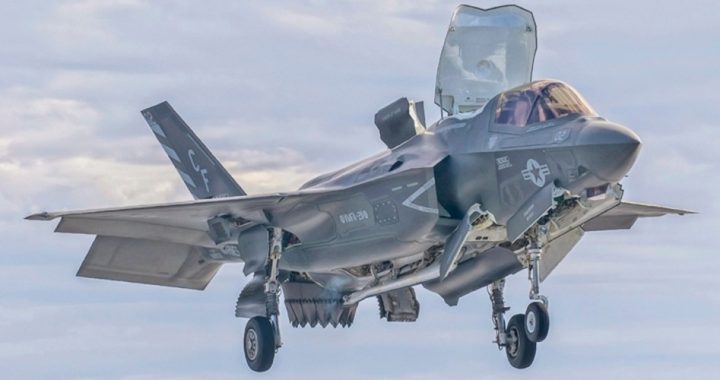
Podcast: Play in new window | Download ()
Subscribe: Android | RSS | More
In a move that could make Admiral Tojo spin in his grave, the United States military is now considering flying aircraft — its F-35B fighters (shown) — off Japan’s largest warships, as per a request by officials in Tokyo.
As a result, the “service is now studying the feasibility of deploying short take-off vertical landing (STOVL) fighters from JS Izumo (DDH-183) and JS Kaga (DDH-184), Japan’s 24,000-ton big deck amphibious [ships],” reports USNI News.
Providing further detail, UKDJ relates, quoting outlet Asahi:
“The government has also approved a plan to purchase U.S.-made F-35B fighter jets which have short take-off and vertical landing capabilities. The F-35B jets will be mainly used on the Izumo and Kaga, but the aircraft will not be deployed until after fiscal 2024. That leaves open the possibility of at least a three-year period when the Izumo would be capable of being used as an aircraft carrier, but with the Air SDF [Self-Defense Force] having no such aircraft in its arsenal.
According to several government sources, when Gen. Robert Neller, who was then commandant of the U.S. Marine Corps, visited Japan in March, Defense Ministry officials briefed him on the plans to retrofit the Izumo and said U.S. military F-35B jets would likely be the first to use the Izumo after it became a flattop. They asked for U.S. cooperation and advice in the operation of the F-35B jets. The U.S. jets would likely use the Izumo during joint training exercises with the SDF as well as when U.S. jets faced an emergency situation requiring immediate landing.”
Given that Japan technically has a “pacifist” constitution — essentially stating that military forces with war potential, such as “attack aircraft carriers,” must not be maintained — such moves are always a delicate issue. Responding to this concern, Defense Minister Takeshi Iwaya said in December 2018 that the “Izumo was originally designed as a multipurpose escort ship, so it wouldn’t pose any threat to other countries if fighter jets are deployed on it,” reported the Japan Times. “He added the upgraded Izumo would not be an ‘attack aircraft carrier’” (in name, anyway!).
While Japan’s constitution was imposed post-WWII by the United States, we’re now encouraging the nation’s rearmament to counterbalance China. As USNI News also reports:
“Chinese naval capabilities are growing rapidly in the region and I think this is an important step in strengthening the US-Japanese alliance. The Japanese acquisition of F-35Bs will enhance their maritime and aviation capabilities in the region and will further bolster interoperability between Japanese and U.S. military forces,” Eric Wertheim, author of U.S. Naval Institute’s Combat Fleets, told USNI News, Friday. “It will also help ease the burden on U.S. assets that are stretched thin responding to a long list of global crises.”
Beijing has been critical of Japan’s move to put fighters on the two warships saying that they could be considered an attack platform and a violation of Japan’s pacifist constitution.
China and the United States have for the last decade been engaged in a “Cold War” in the South China Sea. Beijing has claimed approximately 80 percent (perhaps one million square miles of water) of the area for itself — in violation of international law — even going so far as to build artificial islands to facilitate this oceanic conquest.
In fact, some nationalistic Chinese officials have even recommended that their navy ram and sink U.S. naval vessels operating in the area and kill a vast number of American servicemen in order to “frighten” Washington away from the region.
What’s China’s motivation? Not only does Beijing want power, influence (and perhaps glory), but also the region’s natural resources. China’s “instant island” (just add sand) endeavors, for example, could mean that the resources for 200 miles around these Chinese outposts “would be Chinese; no fishing or exploration or drilling for oil and gas without Beijing’s say-so,” as the Daily Signal put it in 2015.
This doesn’t sit well with Brunei, the Republic of China (Taiwan), Malaysia, Indonesia, the Philippines, and Vietnam, which are directly involved in, and affected by, the South China Sea dispute. But the most significant regional U.S. ally in the battle against Beijing is the latter’s historical adversary Japan.
Unbeknownst to many, the Land of the Rising Sun has been rising militarily and now has the world’s fourth or fifth most powerful navy (though, technically, it’s the “Maritime Self-Defense Force” — wink, nod), depending upon which assessment you believe. “Largely under the radar,” National Interest wrote in 2014, “Japan has built up one of the largest, most-advanced and professionally manned naval forces in the world.”
Japan also has the world’s sixth most powerful military overall, according to GlobalFirepower.com. As CNN related in 2016, “‘Pilot for pilot, ship for ship, Japan can stand toe to toe with anybody,’ said John T. Kuehn, a professor of military history at the U.S. Army Command and General Staff College.’”
Hopefully, no one will have to go toe to toe with China. But if it does happen, you could certainly do worse than being arm in arm with Japan.



